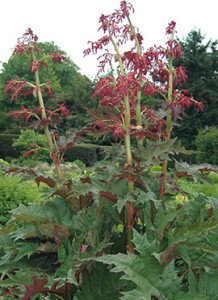Hello fellow readers, One of the plants my colleague Marty and I touted in our recent talk at the Springfest Garden Show on Deer Resistant Plants was ornamental rhubarb. Artie stumped us when he asked for the botanical name. Rheum, pronounced ree’ um, is the genus of rhubarb, but what species is the ornamental kind? Good question, and after researching further, I don’t have a definitive answer.
What species of rhubarb is edible versus ornamental?
Rheum palmatum is commonly known as Chinese rhubarb (maybe also ornamental rhubarb?) and is not edible. Rheum rhabarbarum is considered the edible kind (also known as R. rhaponticum), commonly referred to as wild rhubarb in the U.S. and garden rhubarb elsewhere. You can see why common names for plants are confusing.
Rheum rhabarbarum’s leaf stalks are edible, but the leaf blades contain oxalic acid toxic to both deer and humans. The leaves’ impart cathartic and laxative properties,’ according to Wikipedia. In ‘Mary’s words,’ the leaves trigger an overdose of the Ex-Lax effect.
Edible rhubarb can be attractive in a garden, but it’s the ornamental, not-edible kind that makes a dramatic, almost prehistoric-looking focal point in your garden. One of the favored and most colorful is Rheum palmatum var. tanguticum. Growing nearly 6-feet high and 3-feet wide, their huge pointy-edged leaves unfurl bronzy-red then turn green on top and dark burgundy underneath. They bloom funky spikes of reddish-pink flowers on tall maroon stalks in summer. In the fall, the leaves shift to red for a dramatic ending until next year. Just as the edible kind, ornamental rhubarb are perennial, returning every year. Rheum’ Ace of Hearts’ is a popular smaller ornamental rhubarb, about 3-feet tall and wide.
Where to find and when to plant edible or ornamental rhubarb.
Rhubarb is generally purchased as crowns or divisions and is best planted in early spring when still dormant. They can be tough to find locally but are available mail-order or online. They thrive in humus-rich, moist soil and like partial shade to full sun, but they appreciate if their roots are kept cool with mulch as they detest extreme heat.
CAUTION: Ornamental rhubarb is harmful if eaten! And that goes for you too, deer. Though some deer seem to ignore the warning label from time to time– maybe they’re using it for medicinal purposes to promote regularity? Jeez.
Garden Dilemmas? AskMaryStone@gmail.com
To learn about skunk cabbage, which shares oxalic acid in common with rhubarb, click through to Skunk Cabbage Appeal.
And, you can tune into the podcast version of this story
Column updated April 16, 2021




Are there some defining characteristics that will tell me if my rhubarb plant is edible or ornamental?
Hello, Kate Thank you for your question. Edible rhubarb is far “beefier” in terms of its size and thick stalks. I think they too can be beautiful in the garden. I have Rheum, Ornamental Rhubarb ‘Cawood Delight,’ with burgundy-green foliage and deep maroon stems. Very pretty. I appreciate you reading my column. Happy Gardening, Mary
Hello,
According to two sources I found Rheum palmatum stems are edible, but not the leaves, but some gardening websites say it is not, which is confusing. Where does the information come from?
Thank you
Sources:
https://pfaf.org/user/Plant.aspx?LatinName=Rheum+palmatum
https://pubs.rsc.org/en/content/articlelanding/2022/fo/d1fo04214a#:~:text=Rhubarb%20has%20edible%20stems%20or,essential%20amino%20acids%20and%20minerals.
Thanks for writing in, Jonas; my information about the Chinese rhubarb, Rheum palmatum, came from plant suppliers I use for my landscape and garden design business. I’m not sure I’m brave enough to eat them to see if it’s untrue, but let me know if you have first-hand experience. Thanks for reading my column post, Mary